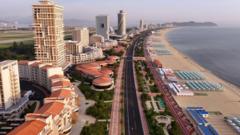As the trade landscape shifts, garment factories in Guangzhou confront a pivotal moment as tariffs and taxation changes threaten their survival in the competitive U.S. market.
China's Garment Industry Faces Crisis Amid New Tariffs

China's Garment Industry Faces Crisis Amid New Tariffs
The end of a tax loophole has forced Chinese apparel manufacturers to rethink their market strategies.
In Guangzhou, China’s garment factory scene is at a crossroads. The impact of new tariffs and a tax regulation change has left many manufacturers, like Liu Miao, in dire straits. Liu, who has successfully sold clothing on platforms such as Amazon, is witnessing a dramatic decline in profits. Previously earning a dollar on each garment sold, he now nets only 50 cents due to the heightened costs of doing business. With the new tariffs making U.S. sales unfeasible, Liu expressed his frustration, stating, “You can’t sell anything to the United States right now. The tariffs are too high.”
This transition has not just affected individual manufacturers but has rattled the entire Chinese apparel industry, which has seen significant growth fueled by exports, especially through e-commerce platforms. In cities like Guangzhou, foreign luxury automobiles are frequent sights outside factories, a stark contrast to the challenges many workers face as their jobs hang in the balance. The backdrop of the competitive garment sector was once alive with the ease of exporting goods to the U.S., where shipments under $800 could enter duty-free.
But with the escalating trade tensions between the United States and China, the landscape is changing rapidly. As garment factories face difficult decisions to adapt or risk closure, entrepreneurs are left weighing their options and considering expansion into alternative markets or relocating production to other countries with lower costs.
As these businesses stand on the brink, the future of China's garment industry remains uncertain, highlighting the widespread repercussions of international trade dynamics on local economies.
This transition has not just affected individual manufacturers but has rattled the entire Chinese apparel industry, which has seen significant growth fueled by exports, especially through e-commerce platforms. In cities like Guangzhou, foreign luxury automobiles are frequent sights outside factories, a stark contrast to the challenges many workers face as their jobs hang in the balance. The backdrop of the competitive garment sector was once alive with the ease of exporting goods to the U.S., where shipments under $800 could enter duty-free.
But with the escalating trade tensions between the United States and China, the landscape is changing rapidly. As garment factories face difficult decisions to adapt or risk closure, entrepreneurs are left weighing their options and considering expansion into alternative markets or relocating production to other countries with lower costs.
As these businesses stand on the brink, the future of China's garment industry remains uncertain, highlighting the widespread repercussions of international trade dynamics on local economies.





















